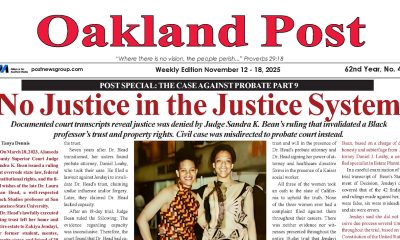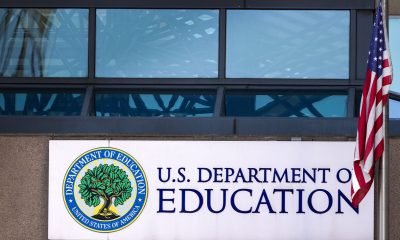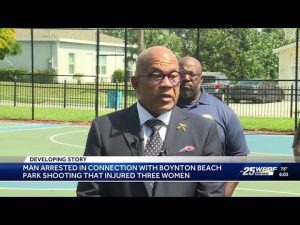#NNPA BlackPress
Memphis People’s Convention all about The People’s Agenda
NNPA NEWSWIRE — As a diverse collection of 500-plus Memphians steadily streamed into the Paradise Entertainment Complex on Georgia Avenue, there wasn’t so much a set slate of candidates as there was a slate of issues – an agenda focused on city finances, education, crime, employment and housing.
Shelby County Commissioner Tami Sawyer was the consensus “People’s Candidate” for mayor.
By Lee Eric Smith, The New Tri-State Defender
Note: TSD’s Lee Eric Smith was on special assignment for both The New Tri-State Defender and MLK50: Justice Through Journalism. A different version of this story can be found at MLK50.com.
In the run-up to The People’s Convention, there were rumblings that the event would be a glorified pep rally for a predetermined slate of candidates in Memphis’ upcoming municipal elections.
But as a diverse collection of 500-plus Memphians steadily streamed into the Paradise Entertainment Complex on Georgia Avenue, there wasn’t so much a set slate of candidates as there was a slate of issues – an agenda focused on city finances, education, crime, employment and housing.
And if there was any doubt how candidates can win the support of the People’s Convention, the Rev. Dr. Earle J. Fisher made it clear in his opening remarks.
“At no point in recent history have we had 20 candidates for elected office gathered to be vetted by a group like this,” said Fisher, founder of #UpTheVote901, which organized the convention. “And be very clear: We are not here because of them. They are here because of us.”

After registering, attendees received a handout titled “Memphis People’s Convention Agenda.” The document said that more than 2,200 Memphians were surveyed to identify the most important issues ahead of city elections in October. “Anybody who cannot support and endorse this (agenda) is not capable of providing the political service that we need,” Fisher said.
Organizers say that more than 900 people registered online for the Convention, though only about 500 of those attended. However, another 150 people registered onsite to push the attendance above 650. Those numbers, combined with the more than 2,200 online surveys, made organizers feel they’d achieved a solid but accurate sampling of the city.
And by the end of the convention, current Shelby County Commissioner Tami Sawyer was the consensus “People’s Candidate” for mayor.
Endorsements for other offices include: Judge: Jayne Chandler; City Council #4: Britney Thornton; City Council #6: Theryn C. Bond; City Council #7: Michalyn C. S. Easter-Thomas; City Council #8.1: Pearl Eva Walker; City Council #8.2: Frank W. Johnson; and City Council #9.1: Erika Sugarmon.
“The truth is, this is probably as diverse an event as we’ve seen in Memphis but still representative of the demographic,” said co-organizer Sijuwola Crawford. “There were people who are black or African American, white or Caucasian, people of Hispanic or Latinx descent. There were people we know who identify as gay and trans(gender). Christians. Nation of Islam. People who identify as not religious. Business owners and the working poor and unemployed.
“We saw a great representation of what Memphis looks like – and what it can look like in the future,” he added. “This was a great step in that direction.”
“We saw a great representation of what Memphis looks like – and what it can look like in the future,” he added. “This was a great step in that direction.”
The agenda, which was officially unveiled at the convention, was broken into five major categories, with multiple policy points under each. Among the key policies on the agenda:
- City Budget: Directly include community members in the city’s budgeting process.
- Education: Measures for student and teacher success that are untethered to standardized testing. The agenda also calls for free access to art and music instruction.
- Crime and Safety: More support services, including those for mental health and homelessness. The agenda also calls for the decriminalization of marijuana.
- Labor and Wages: The agenda calls for the City of Memphis, companies that receive PILOTS (payment in lieu of taxes) and temporary staffing agencies to pay employees a living wage.
- Affordable Housing: Creation of a public agency to end homelessness, as well as construction of more homeless shelters. The agenda also calls for increased regulations on landlords to ensure property maintenance and fair eviction processes.
And that was just the “official” people’s agenda. Partner organizations to #UpTheVote901 were given time to advocate for a variety of other issues, including reproductive rights, a new green deal and the restoration of voting rights for the formerly incarcerated.
At stake, said Crawford, is more than just an endorsement, or even votes. The idea is to mobilize money, resources and volunteers around “The People’s Candidates,” as convention organizers called endorsed candidates.
“Our work is going to be (about) how do we build this base for the agenda first, and then for candidates who align with that agenda,” Crawford said. “That’ s just the hard work of getting out and having difficult conversations with people.
“People are disengaged and disenchanted because they don’t feel a part of this political process,” he continued. “But what we want to show people is that there is power in our numbers. And we want to link candidates with these issues and from there, with a wider base, we want to move these people to the polls . . . and beyond.”

The convention applied a version of “ranked choice voting” – a method of voting where voters rank multiple candidates on a ballot. For the People’s Convention, participants voted using Menti.com, an online app that collects and presents audience feedback in real time.
Even that method of voting was its own political statement. On multiple occasions, Memphis voters have already approved a form of ranked voting for municipal elections, but implementation has stalled. The convention’s election process provided a learn-by-doing example of how such a ballot would work.
It’s been said that the democratic process is neither quick nor neat, and the Memphis People’s Convention was no different. Even as the event started nearly an hour after its listed time, people were still filing in. And as a political event, there were impassioned political speeches that stretched the convention into late Saturday afternoon.
Among those giving brief remarks was Shep Wilbun, one of the organizers of the 1991 Peoples Convention. That year, Dr. Willie W. Herenton defeated Wilbun to win the People’s Convention – and eventually the mayor’s office itself.
“The times are different. The process is different. The needs are different in some degrees, but your People’s Agenda today is the same as ours,” said Wilbun, a former city councilman. “That’s damning in one sense, and inspiring in another. I told them then that 25 years from now, we would need to have another People’s Convention, because what was done then will have been forgotten.”
But far from berating the current convention, Wilbun echoed calls for voters to hold elected officials accountable.
“People try to say it’s a generational thing. It’s always young people who want to change lives,” said Wilbun, who said he was 38 during the earlier convention. “And no mistake, the people who are favored, the people who are incumbents, they are not people who want change.”
The crowd gradually thinned out over the afternoon, but well over 100 attendees stayed long enough for mayoral candidates Tami Sawyer and Lemichael Wilson to present their cases.
Notably absent was incumbent Mayor Jim Strickland who declined to attend. Herenton, who served as mayor for 17 years and is seeking another term, also was conspicuously absent.
In remarks after the convention, Fisher said that Strickland, Herenton and other candidates had not seen The People’s Agenda, as it hadn’t been released early.
“Now, we fully expect for every candidate to have to respond to The People’s Agenda, and say where they stand,” Fisher said. “What they won’t be able to do is say that they are The People’s Candidate. They won’t be able to say that they were confident enough in the people, compassionate enough towards the people and interested enough in the people’s vision to come out and be vetted by the people.
“We won’t allow them to try to skirt the process,” Fisher said.
Fisher also challenged news outlets to press Strickland, Herenton and others on their reasons for sitting out the convention.
“Ask every one of them to thoroughly explain exactly why they did not come. And don’t settle for a coy answer, like the event was predetermined,” Fisher said. “Ask the candidates who participated in this. Ask them if it was fair, if it was thorough, if it was open to everybody.
“This was not biased,” he continued. “This was much more objective and fair and equitable than the Shelby County Election Commission elections. So don’t let them off the hook easy. Because what they’ll do is put more pressure on us to defend our process and then we will put (more pressure) on them to defend their public record.
“We’re defending our process,” Fisher said. “Make them defend their public record.”
#NNPA BlackPress
LIHEAP Funds Released After Weeks of Delay as States and the District Rush to Protect Households from the Cold
BLACKPRESSUSA NEWSWIRE — The federal government has released $3.6 billion in home heating assistance after a delay that left states preparing for the start of winter without the program’s annual funding.

By Stacy M. Brown
Black Press USA Senior National Correspondent
The federal government has released $3.6 billion in home heating assistance after a delay that left states preparing for the start of winter without the program’s annual funding. The Low-Income Home Energy Assistance Program, known as LIHEAP, helps eligible households pay heating and cooling bills. The release follows a shutdown that stretched 43 days and pushed agencies across the country to warn families of possible disruptions.
State officials in Minnesota, Kansas, New York, and Pennsylvania had already issued alerts that the delay could slow the processing of applications or force families to wait until December for help. In Pennsylvania, more than 300,000 households depend on the program each year. Minnesota officials noted that older adults, young children, and people with disabilities face the highest risk as temperatures fall.
The delay also raised concerns among advocates who track household debt tied to rising utility costs. National Energy Assistance Directors Association Executive Director Mark Wolfe said the funds were “essential and long overdue” and added that high arrearages and increased energy prices have strained families seeking help.
Some states faced additional pressure when other services were affected by the shutdown. According to data reviewed by national energy advocates, roughly 68 percent of LIHEAP households also receive nutrition assistance, and the freeze in multiple programs increased the financial burden on low-income residents. Wolfe said families were placed in “an even more precarious situation than usual” as the shutdown stretched into November.
In Maryland, lawmakers urged the Trump administration to release funds after the state recorded its first cold-related death of the season. The Maryland Department of Health reported that a man in his 30s was found outdoors in Frederick County when temperatures dropped. Last winter, the state documented 75 cold-related deaths, the highest number in five years. Rep Kweisi Mfume joined more than 100 House members calling for immediate federal action and said LIHEAP “is not a luxury” for the 100,000 Maryland households that rely on it. He added that seniors and veterans would be placed at risk if the program remained stalled.
Maryland Gov. Wes Moore used $10.1 million in state funds to keep benefits moving, but noted that states cannot routinely replace federal dollars. His administration said families that rely on medical equipment requiring electricity are particularly vulnerable.
The District of Columbia has already mapped out its FY26 LIHEAP structure in documents filed with the federal government. The District’s plan shows that heating assistance, cooling assistance, weatherization, and year-round crisis assistance operate from October 1 through September 30. The District allocates 50 percent of its LIHEAP funds to heating assistance, 10 percent to cooling, 13 percent to year-round crisis assistance, 15 percent to weatherization, and 10 percent to administrative costs. Two percent is used for services that help residents reduce energy needs, including education on reading utility bills and identifying energy waste.
The District’s plan lists a minimum LIHEAP benefit of $200 and a maximum of $1,800 for both heating and cooling assistance. Crisis benefits are provided separately and may reach up to $500 when needed to resolve an emergency. The plan states that a household is considered in crisis if it has been disconnected from energy service, if heating oil is at 5 percent or less of capacity, or if the household has at least $200 owed after the regular benefit is applied.
The District’s filing notes that LIHEAP staff conduct outreach through community meetings, senior housing sites, Advisory Neighborhood Commissions, social media, posters, and mass mailings. The plan confirms that LIHEAP applicants can apply in person, by mail, by email, or through a mobile-friendly online application and that physically disabled residents may request in-home visits.
As agencies nationwide begin distributing the newly released funds, states continue working through large volumes of applications. Wolfe said LIHEAP administrators “have been notified that the award letters have gone out and the states can begin to draw down the funds.”
#NNPA BlackPress
Seven Steps to Help Your Child Build Meaningful Connections
BLACKPRESSUSA NEWSWIRE — Swinging side by side with a friend on the playground. Sharing chalk over bright, colorful sidewalk drawings. Hiding behind a tree during a spirited game of hide-and-seek. These simple moments between children may seem small, but they matter more than we think

By Niyoka McCoy, Ed.D., Chief Learning Officer, Stride/K12
Swinging side by side with a friend on the playground. Sharing chalk over bright, colorful sidewalk drawings. Hiding behind a tree during a spirited game of hide-and-seek. These simple moments between children may seem small, but they matter more than we think: They lay the foundation for some of life’s most important skills.
Through everyday play, young children begin learning essential social and emotional skills like sharing, resolving conflicts, showing empathy, and managing their emotions. These social skills help shape emotional growth and set kids up for long-term success. Socialization in early childhood isn’t just a “nice-to-have”—it’s essential for development.
Yet today, many young children who haven’t yet started school aren’t getting enough consistent, meaningful interaction with peers. Research shows that there’s a decline in active free play and peer socialization when compared to previous generations.
There are many reasons for this. Children who are home with a parent during the day may spend most of their time with adults, limiting opportunities for peer play. Those in daycare or preschool may have restricted free play, and large classrooms can reduce supervision and social coaching. Some children live in rural areas, are homebound due to illness, have full schedules, or rely on screens to fill their playtime. And for some families, finding other families with young children to connect with isn’t easy.
While these challenges can feel significant, opportunities for connection still exist in every community. Families can take simple steps to help children build friendships, create a sense of belonging, and strengthen social skills. Here are some ideas to get started:
- Storytime sessions at libraries or local bookstores
- Community offerings such as parent-child workshops, art, music, gymnastics, swimming, or sports programs
- Weekly events at children’s museums, which may include art projects, music workshops, or science experiments
- Outdoor exploration, where kids can play with peers
- Local parenting groups that organize playdates and group activities
- Volunteer opportunities where children can participate, such as pet adoption events or packing meals at a food bank
- Classes for kids at local businesses, including hardware, grocery, or craft stores
Some of these community activities are free or low-cost and give kids the chance to build friendships and practice social skills. Parents can also model positive social behavior by interacting with other parents and encouraging their children to play with their peers.
These may seem like small moments of connection, but they can have a powerful impact. Every time your child shares a toy, plays make-believe with peers, or races a friend down the slide, they’re not just playing—they’re learning the skills that build confidence, empathy, and lasting friendships. And it’s good for you, too. Creating intentional opportunities for play also helps you strengthen your own network of parents who can support one another as your children grow together.
#NNPA BlackPress
Seven Steps to Help Your Child Build Meaningful Connections
BLACKPRESSUSA NEWSWIRE — Swinging side by side with a friend on the playground. Sharing chalk over bright, colorful sidewalk drawings. Hiding behind a tree during a spirited game of hide-and-seek. These simple moments between children may seem small, but they matter more than we think

By Niyoka McCoy, Ed.D., Chief Learning Officer, Stride/K12
Swinging side by side with a friend on the playground. Sharing chalk over bright, colorful sidewalk drawings. Hiding behind a tree during a spirited game of hide-and-seek. These simple moments between children may seem small, but they matter more than we think: They lay the foundation for some of life’s most important skills.
Through everyday play, young children begin learning essential social and emotional skills like sharing, resolving conflicts, showing empathy, and managing their emotions. These social skills help shape emotional growth and set kids up for long-term success. Socialization in early childhood isn’t just a “nice-to-have”—it’s essential for development.
Yet today, many young children who haven’t yet started school aren’t getting enough consistent, meaningful interaction with peers. Research shows that there’s a decline in active free play and peer socialization when compared to previous generations.
There are many reasons for this. Children who are home with a parent during the day may spend most of their time with adults, limiting opportunities for peer play. Those in daycare or preschool may have restricted free play, and large classrooms can reduce supervision and social coaching. Some children live in rural areas, are homebound due to illness, have full schedules, or rely on screens to fill their playtime. And for some families, finding other families with young children to connect with isn’t easy.
While these challenges can feel significant, opportunities for connection still exist in every community. Families can take simple steps to help children build friendships, create a sense of belonging, and strengthen social skills. Here are some ideas to get started:
- Storytime sessions at libraries or local bookstores
- Community offerings such as parent-child workshops, art, music, gymnastics, swimming, or sports programs
- Weekly events at children’s museums, which may include art projects, music workshops, or science experiments
- Outdoor exploration, where kids can play with peers
- Local parenting groups that organize playdates and group activities
- Volunteer opportunities where children can participate, such as pet adoption events or packing meals at a food bank
- Classes for kids at local businesses, including hardware, grocery, or craft stores
Some of these community activities are free or low-cost and give kids the chance to build friendships and practice social skills. Parents can also model positive social behavior by interacting with other parents and encouraging their children to play with their peers.
These may seem like small moments of connection, but they can have a powerful impact. Every time your child shares a toy, plays make-believe with peers, or races a friend down the slide, they’re not just playing—they’re learning the skills that build confidence, empathy, and lasting friendships. And it’s good for you, too. Creating intentional opportunities for play also helps you strengthen your own network of parents who can support one another as your children grow together.
-

 Activism4 weeks ago
Activism4 weeks agoOakland Post: Week of November 5 – 11, 2025
-

 Activism3 weeks ago
Activism3 weeks agoOakland Post: Week of November 12 – 18, 2025
-

 Activism2 weeks ago
Activism2 weeks agoIN MEMORIAM: William ‘Bill’ Patterson, 94
-

 Activism3 weeks ago
Activism3 weeks agoHow Charles R. Drew University Navigated More Than $20 Million in Fed Cuts – Still Prioritizing Students and Community Health
-

 #NNPA BlackPress3 weeks ago
#NNPA BlackPress3 weeks agoThe Perfumed Hand of Hypocrisy: Trump Hosted Former Terror Suspect While America Condemns a Muslim Mayor
-

 Bay Area3 weeks ago
Bay Area3 weeks agoNo Justice in the Justice System
-

 #NNPA BlackPress3 weeks ago
#NNPA BlackPress3 weeks agoProtecting Pedophiles: The GOP’s Warped Crusade Against Its Own Lies
-

 #NNPA BlackPress4 weeks ago
#NNPA BlackPress4 weeks ago2026 Subaru Forester Wilderness Review: Everyday SUV With Extra Confidence
























































